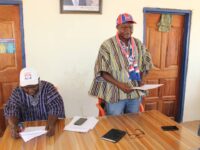 The World Health Organization (WHO) says the 60-day goals it set itself for tackling the Ebola outbreak in West Africa have largely been met.
The World Health Organization (WHO) says the 60-day goals it set itself for tackling the Ebola outbreak in West Africa have largely been met.
The WHO set a target of isolating and treating 70% of patients and of safely burying 70% of victims in Liberia, Sierra Leone and Guinea by 1 December.
The WHO’s Dr Bruce Aylward said only the treatment figure in Sierra Leone had fallen below the mark.
He warned much work was still needed to get to “zero cases”.
The WHO’s latest report put the death toll from the Ebola outbreak at 6,928 in the three hardest-hit West African countries.
However, Dr Aylward said about 1,000 deaths reported at the weekend from Liberia were “actually non-Ebola deaths… and we will be taking them off”.
‘Strong leadership’
Dr Aylward, the assistant director general in charge of Ebola response for the WHO, said the “yawning gap” between disease levels and the capacity to cope had narrowed significantly.
This was a “very very different place than 60 days ago”, he said.
line
Analysis: Mark Doyle, BBC international development correspondent, in Freetown, Sierra Leone
Whenever you read any Ebola statistic, take it with a bucket load of salt. The UN response mission and the World Health Organization base many of their stats on a hotchpotch of numbers from national health ministries, aid organisations and sketchy information their own officials can correlate.
I’ve often seen statistics claiming an improvement or a decline in a particular area – and then subsequently heard a first-hand report contradicting that. The truth is this crisis is taking place in one of the poorest corners of the world. All three worst-affected countries have bad roads, unreliable electricity supplies, severely under-resourced governments and poorly educated populations.
So don’t expect the numbers to add up every time. Foreign aid workers and journalists want things to be neat. Around here they are not. We do know one thing for certain. The number of dead is definitely an underestimate.
line





